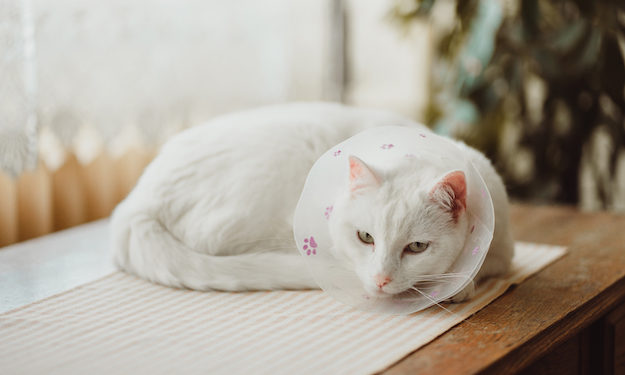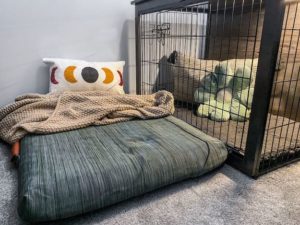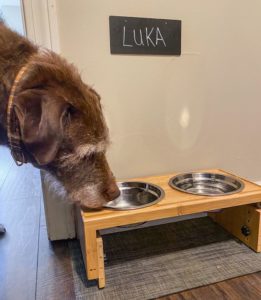Preparing for Your Pet’s Surgery

Feeling anxious and overwhelmed when your pet needs surgery is understandable but knowing how to prepare for their procedure can help. Calm your worries by taking steps to ensure your pet is ready for surgery and to prepare your home for their recovery.
At Ethos Veterinary Health, our veterinary professionals prioritize your pet’s safety during surgery. Rest assured, they’re in good hands when hospitalized with us. Here’s some information about how you can prepare your pet and your home for a few common surgical procedures.
Preparing for Your Pet’s Spay or Neuter
Spay and neuter procedures are the most common veterinary surgeries and are extremely important to control the stray population and decrease the number of pets in animal shelters. Spaying and neutering your pet also protects them from certain health complications and prevents some behavioral issues. Tips to prepare for your pet’s spay or neuter include:
Before surgery
- Crate train your pet — To allow the incision to heal appropriately, your pet’s activity should be restricted for several days after surgery. Familiarizing your pet with their crate before their surgery can help facilitate their confinement during their recovery.
- Withhold food and water — Our veterinary team will provide strict instructions that you must follow, about withholding food (and, in some cases, water) on the night before your pet’s procedure to prevent complications during surgery.
- Stay calm — Your pet can sense when you are nervous, and they feed off your emotions. Stay calm and reassure your pet, so they don’t become anxious when you bring them to the hospital.
After surgery
- Provide pain relief — After a spay or neuter procedure, pets are typically sent home with pain medication. Often pets don’t exhibit pain like humans, and you may think your pet doesn’t need the medication but following all discharge instructions will help your pet recover as quickly as possible.
- Monitor your pet’s incision — Monitor your pet’s surgical incision for heat, redness, and swelling, which can indicate inflammation or infection. Notify your veterinarian right away if you notice these issues.
- Prevent licking and chewing — Some pets feel the urge to lick or chew their incision, which can cause irritation and potentially infection. If necessary, use an Elizabethan collar to keep your pet from licking or chewing their incision.
Preparing for Your Pet’s Orthopedic Surgery
Pets recovering from orthopedic surgeries, such as tibial plateau leveling osteotomy (TPLO) or hip replacement, must be confined to prevent injury and facilitate the healing process. Tips to prepare for your pet’s orthopedic surgery include:
Before surgery
- Create a proper healing area — A comfortable, confined space will help ensure your pet doesn’t run, jump, or climb on furniture. Options include:
- Small room — For large dogs, a small, quiet room with no soft furniture (beds/couches) is ideal for recovery. If possible, choose a room close to the yard to make bathroom breaks easier. Block off any stair access with a gate.
- Crate — Use an appropriately sized crate to restrict activity for medium-sized dogs.
- Upside down playpen — For small dogs and cats, an upside-down playpen is a good option for post-surgical confinement. Turning the pen upside down prevents your pet from jumping over the top.
- Provide a comfortable bed — Ensure your pet’s healing area includes a comfortable, good quality bed on the floor or in the crate. Your pet needs sleep so they can heal as quickly as possible, and a nice resting place helps ensure they are as comfortable as possible. Check out some options here!

- Elevate food and water bowls — Elevating your pet’s food and water bowls ensures they are able to eat and drink without discomfort while they recover.

- Provide traction — Place rugs or better yet, yoga mats, on slippery surfaces, such as tile and hardwood floors, to minimize your pet’s chances of falling during their recovery.
After surgery
- Follow discharge instructions — Ensure you thoroughly understand your pet’s discharge instructions and that you follow all directions about administering medications and caring for your pet’s incision. Contact your veterinarian immediately if you have any questions or concerns about your pet’s recovery.
- Make recheck appointments — If possible, make your pet’s recheck appointments before you leave the hospital to ensure your pet receives the necessary follow up care.
- Ensure your pet can rest — Isolate your pet from other household animals, and ensure your children understand that your pet needs to be left alone during their recovery.
- Provide potty breaks — The intravenous fluids your pet received during surgery may make them urinate more frequently. Help your pet take potty breaks every few hours, keeping them on a short leash.
- Offer entertainment — Staying confined is hard for pets, but mental stimulation, such as food puzzle games, can help keep them cooperative as they recover.
- Decrease your pet’s calories — Pets recovering from surgery don’t burn as many calories, so cut your pet’s calories by 25% to 30% to avoid weight gain.
Preparing for Your Pet’s Cataract Surgery
Cataract surgery is typically performed when the pet’s vision is significantly impaired. The procedure can be performed on one or both eyes to restore eyesight and improve the pet’s quality of life. Tips to prepare for your pet’s cataract surgery include:
Before surgery
- Eliminate concurrent infections — Eyes are susceptible to infection from other parts of the body, which can be a devastating complication for a pet recovering from cataract surgery, so every infection must be eliminated before this surgery. Skin and ear infections must be treated aggressively, and pets who are affected by chronic infections should be given an appropriate antimicrobial for one to two weeks prior to surgery to minimize the possibility of an eye infection. Veterinarians recommend that all pets receive a professional veterinary dental cleaning to address dental disease, and a urinalysis to rule out urinary tract disease.
- Control diabetes — Diabetes is a common cause of cataracts, and your pet’s diabetes should be well controlled before cataract surgery is performed.
- Administer medications — Topical eye medications should be administered for 10 to 14 days prior to surgery to control internal eye inflammation.
After surgery
- Medicate your pet’s eyes — Your pet will need a minimum of two different topical eye medications at least four times daily. Depending on your pet’s response, the frequency can usually be tapered off slowly after the first month.
- Administer oral medications — Anti-inflammatory medications and possibly antibiotics are typically administered for about 10 to 14 days.
- Clean your pet’s eyes — Discharge often accumulates and creates a crust on your pet’s eyelids in the days following surgery. Clean your pet’s eyes with a clean cloth or cotton balls as needed to remove this material.
- Provide an Elizabethan collar — Pets should wear an Elizabethan collar at all times for about four weeks after surgery to prevent them from rubbing their eyes, which could cause vision-threatening complications.
- Use a harness leash — Dogs should only be walked with a harness-style leash.
- Keep your pet quiet — You should keep your pet quiet—no running, chasing toys, or jumping on furniture—for approximately four weeks post-surgery.
Knowing how to prepare for your pet’s surgical procedure can boost your confidence and help ensure your pet recovers as quickly as possible. Contact our Ethos Veterinary Health team if you have questions about your pet’s upcoming surgery.